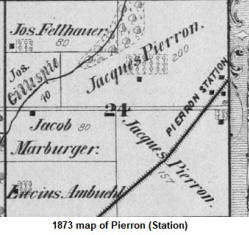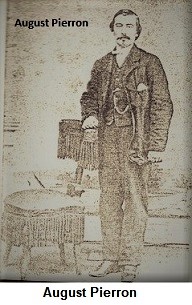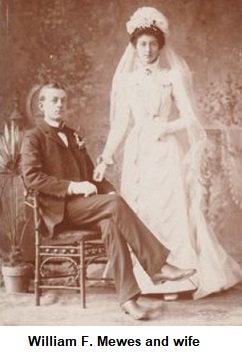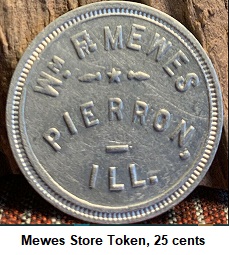Early History of Pierron
Founding of Pierron

Early Businesses
 Upon
completion of the railroad in 1869, August Pierron, a son of Jacques
Pierron, erected a building which was used as a barroom and grocery
store. In February 1870, the post office was established, with
August Pierron serving as postmaster. August Pierron died January 1,
1896, and is buried in the Calvary Cemetery in Pierron. His father,
Jacques Pierron, died October 12, 1886, and is buried in the St.
Joseph’s Cemetery in Highland, Illinois. Pierron was incorporated as
a village in 1893.
Upon
completion of the railroad in 1869, August Pierron, a son of Jacques
Pierron, erected a building which was used as a barroom and grocery
store. In February 1870, the post office was established, with
August Pierron serving as postmaster. August Pierron died January 1,
1896, and is buried in the Calvary Cemetery in Pierron. His father,
Jacques Pierron, died October 12, 1886, and is buried in the St.
Joseph’s Cemetery in Highland, Illinois. Pierron was incorporated as
a village in 1893.
Pierron & Rinderer carried on a business as general merchants for
four years. After their dissolution, J. D. Rinderer built a large
storehouse on the Bond County side of Main Street.
The first warehouse for grain in Pierron was built in 1870 by J.
Pierron and L. Knebel. In 1880, L. Knebel built an elevator at a
cost of $5,000, capable of storing 20,000 bushels of grain. In 1870,
J. Weindel opened a blacksmith shop. The first hotel was opened by
Charles Britsch in 1870.
By 1882, the following businesses operated in Pierron:
General Merchandise – Suppiger & Utiger
Agricultural Implements – August Pierron
Wagon Makers – G. Schwarz and F. Helbolt
Grain and Lumber – L. Knebel & Co.
Physician and Surgeon – Dr. M. D. Tibbitts
Saddler – R. Balsiger
Blacksmiths – R. Lang and W. Seegar
Carpenter and builder – J. Bosler
Hotels – J. Kurz, F. Haenny and L. Lehnert
Dressmaker – Mrs. R. Balsiger
By 1912, the village had nearly three hundred inhabitants, a large
Catholic Church, a public schoolhouse, two general stores, and the
Pierron Mercantile Company. There was also Mewes & Schrumpf, a
blacksmith and wagon maker, three saloons, a builder, concrete
works, lumber yard, grain elevator, and a hardware store.
Prominent Pierron Citizens
One of the foremost citizens of Pierron was
William F. Mewes, head of the
A native of Bond County, Illinois, Philip
M. Essenpreis was born February 13, 1866, near Pierron, on
the farm of his father, Leon Essenpreis. Philip clerked in different
Pierron stores, including general hardware establishments, until
1886. He then engaged in farming in Bond County for thirteen years.
In 1899, he returned to Pierron where he engaged in the grain and
lumber business. On April 19, 1887, Essenpreis married Anna Weindel.
A son of Emil Tribout, Adolph P. Tribout
was born January 30, 1876, in St. Clair County, Illinois. His
grandparents, Bellefontiere and Marguerite Tribout, were of French
ancestry. Adolph, after leaving home, moved to East St. Louis where
he found work in a large steel plant. He was rapidly promoted until
reaching the position of foreman of the plant. Several years later
he moved to Edgemont, where he worked in mining for three years. He
then moved to Pierron, where he owned a general store and harness
shop. On October 8, 1901, he married Elise Gauch. Adolph was a
baseball enthusiast, and served as manager and captain of many
baseball teams. While in St. Louis, he played on the old team of the
“Reds” until the formation of the “Trolley League.”
